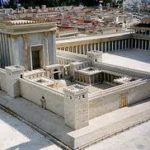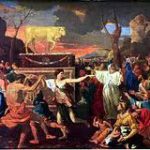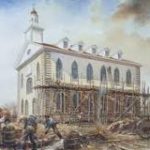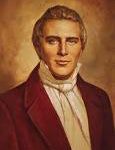The Temple Doctrine The temple is truly a place where you are “in the world and not of the world.” When you are troubled and have crucial decisions that weigh heavily on your mind and soul, you can take your cares to the temple and receive spiritual guidance. We need to acquire a testimony and a reverent feeling of the temple being the house of the Lord. To preserve the sanctity of the temple and to invite the Spirit to bless those who enter the holy temple for their ordinances and covenants, we are taught that no unclean thing should enter the temple. Reverence in the temple is a vital element in inviting the Spirit to reside within it every hour of every day. Elder Robert D. Hales of the Quorum of the Twelve Apostles, Ensign Oct 2009 ************************************************************************************* Hanukkah (Dedication) of the Second Temple – Second Century B.C.  More than 2000 years ago there was a time when the land of Israel was part of the Syrian-Greek Empire, dominated by Syrian rulers of the dynasty of the Seleucids. In order to relate the story that led up to Chanukah, we shall start with Antiochus III, the King of Syria, who reigned from 3538 to 3574 (222-186 B.C.). He had waged war with King Ptolemy of Egypt over the possession of the Land of Israel. Antiochus III was victorious and the Land of Israel was annexed to his empire. At the beginning of his reign he was favorably disposed toward the Jews and accorded them some privileges. Later on, however, when he was beaten by the Romans and compelled to pay heavy taxes, the burden fell upon the various peoples of his empire who were forced to furnish the heavy gold that was required of him by the Romans. When Antiochus died, his son Seleucus IV took over, and further oppressed the Jews.
More than 2000 years ago there was a time when the land of Israel was part of the Syrian-Greek Empire, dominated by Syrian rulers of the dynasty of the Seleucids. In order to relate the story that led up to Chanukah, we shall start with Antiochus III, the King of Syria, who reigned from 3538 to 3574 (222-186 B.C.). He had waged war with King Ptolemy of Egypt over the possession of the Land of Israel. Antiochus III was victorious and the Land of Israel was annexed to his empire. At the beginning of his reign he was favorably disposed toward the Jews and accorded them some privileges. Later on, however, when he was beaten by the Romans and compelled to pay heavy taxes, the burden fell upon the various peoples of his empire who were forced to furnish the heavy gold that was required of him by the Romans. When Antiochus died, his son Seleucus IV took over, and further oppressed the Jews.  Added to the troubles from the outside were the grave perils that threatened Judaism from within. The influence of the Hellenists (people who accepted idol-worship and the Syrian way of life) was increasing. Yochanan, the High Priest, foresaw the danger to Judaism from the penetration of Syrian-Greek influence into the Holy Land. For, in contrast to the ideal of outward beauty held by the Greeks and Syrians, Judaism emphasizes truth and moral purity, as commanded by God in the holy Torah. The Jewish people could never give up their faith in God and accept the idol-worship of the Syrians… So begins the story of the destruction, recapture and rededication of the Temple at Jerusalem. This holiday is also known as the Festival of Lights. I is an eight-day Jewish holiday commemorating the rededication of the Holy Temple (the Second Temple) in Jerusalem at the time of the Maccabean Revolt of the 2nd century BCE. When the Second Temple in Jerusalem was looted and services stopped, Judaism was outlawed. In 167 BC Antiochus ordered an altar to Zeus erected in the Temple. He banned circumcision and ordered pigs to be sacrificed at the altar of the temple.[20] Antiochus’s actions provoked a large-scale revolt. Mattityahu, a Jewish priest, and his five sons Jochanan, Simeon, Eleazar, Jonathan, and Judah led a rebellion against Antiochus. Hanukkah is observed for eight nights and days, starting on the 25th day of Kislev according to the Hebrew calendar, which may occur at any time from late November to late December in the Gregorian calendar. Modern day celebrations are held in December.
Added to the troubles from the outside were the grave perils that threatened Judaism from within. The influence of the Hellenists (people who accepted idol-worship and the Syrian way of life) was increasing. Yochanan, the High Priest, foresaw the danger to Judaism from the penetration of Syrian-Greek influence into the Holy Land. For, in contrast to the ideal of outward beauty held by the Greeks and Syrians, Judaism emphasizes truth and moral purity, as commanded by God in the holy Torah. The Jewish people could never give up their faith in God and accept the idol-worship of the Syrians… So begins the story of the destruction, recapture and rededication of the Temple at Jerusalem. This holiday is also known as the Festival of Lights. I is an eight-day Jewish holiday commemorating the rededication of the Holy Temple (the Second Temple) in Jerusalem at the time of the Maccabean Revolt of the 2nd century BCE. When the Second Temple in Jerusalem was looted and services stopped, Judaism was outlawed. In 167 BC Antiochus ordered an altar to Zeus erected in the Temple. He banned circumcision and ordered pigs to be sacrificed at the altar of the temple.[20] Antiochus’s actions provoked a large-scale revolt. Mattityahu, a Jewish priest, and his five sons Jochanan, Simeon, Eleazar, Jonathan, and Judah led a rebellion against Antiochus. Hanukkah is observed for eight nights and days, starting on the 25th day of Kislev according to the Hebrew calendar, which may occur at any time from late November to late December in the Gregorian calendar. Modern day celebrations are held in December.  The story is preserved in 1st and 2nd Maccabees, in the Apocrypha. After the forces of Antiochus IV were driven from the Temple, which they captured and desecrated, the Maccabees discovered that almost all of the ritual olive oil had been profaned. They found only a single container that was still sealed by the High Priest, with enough oil to keep the menorah in the Temple lit for a single day. They used this, yet it burned for eight days (the time it took to have new oil pressed and made ready). An eight-day festival was declared by the Jewish sages to commemorate this miracle. There are many traditions associated with this holiday, not counted as one of the most important of Jewish holidays, but the reclaiming of the Temple has great meaning to the Mormons. (Various sources – edited) Kirtland, Ohio Temple Dedication – 27 March 1836 by Joseph Smith, Jr.
The story is preserved in 1st and 2nd Maccabees, in the Apocrypha. After the forces of Antiochus IV were driven from the Temple, which they captured and desecrated, the Maccabees discovered that almost all of the ritual olive oil had been profaned. They found only a single container that was still sealed by the High Priest, with enough oil to keep the menorah in the Temple lit for a single day. They used this, yet it burned for eight days (the time it took to have new oil pressed and made ready). An eight-day festival was declared by the Jewish sages to commemorate this miracle. There are many traditions associated with this holiday, not counted as one of the most important of Jewish holidays, but the reclaiming of the Temple has great meaning to the Mormons. (Various sources – edited) Kirtland, Ohio Temple Dedication – 27 March 1836 by Joseph Smith, Jr.  The Kirtland Temple is a National Historic Landmark in Kirtland, Ohio, USA, on the eastern edge of the Cleveland metropolitan area. Owned and operated by the Community of Christ, formerly the Reorganized Church of Jesus Christ of Latter Day Saints (RLDS), the house of worship was the first temple to be built by the Latter Day Saint movement. Beginning in 1831, members of the Church of Christ (Latter Day Saints) under the direction of church founder and president Joseph Smith Jr., began to gather in the Kirtland area. In December 1832 Smith reported to have received a revelation that called for the construction of a house of worship, education, and order. On May 6, 1833, Smith reported that he had received a revelation from God, directing members of the church to construct “a house… wholly dedicated unto the Lord for the work of the presidency,” “dedicated unto the Lord from the foundation thereof, according to the order of the priesthood.” Directions were given to build a “lower court and a higher court,” and a promise given that the Lord’s “glory shall be there, and [his] presence shall be there.” (LDS Doctrine & Covenants D&C 94:3-9 RLDS Doctrine and Covenants Section 91:3).
The Kirtland Temple is a National Historic Landmark in Kirtland, Ohio, USA, on the eastern edge of the Cleveland metropolitan area. Owned and operated by the Community of Christ, formerly the Reorganized Church of Jesus Christ of Latter Day Saints (RLDS), the house of worship was the first temple to be built by the Latter Day Saint movement. Beginning in 1831, members of the Church of Christ (Latter Day Saints) under the direction of church founder and president Joseph Smith Jr., began to gather in the Kirtland area. In December 1832 Smith reported to have received a revelation that called for the construction of a house of worship, education, and order. On May 6, 1833, Smith reported that he had received a revelation from God, directing members of the church to construct “a house… wholly dedicated unto the Lord for the work of the presidency,” “dedicated unto the Lord from the foundation thereof, according to the order of the priesthood.” Directions were given to build a “lower court and a higher court,” and a promise given that the Lord’s “glory shall be there, and [his] presence shall be there.” (LDS Doctrine & Covenants D&C 94:3-9 RLDS Doctrine and Covenants Section 91:3).  The temple was dedicated in an eight-hour service on March 27, 1836. A reported “one thousand persons” attended the gathering, which introduced such traditional dedication rites as the Hosanna Shout and singing of W. W. Phelps’s hymn “The Spirit of God Like a Fire Is Burning.” Following a two-and-a-half hour sermon given by Church leader Sidney Rigdon, Smith offered a dedicatory prayer that had been prepared by a committee of church leaders, which he indicated was given to him by revelation. Two other church leaders, Brigham Young and David W. Patten, were reported to have been inspired to speak in tongues following the prayer (Messenger and Advocate (March 1836)). Truman O. Angell recorded in his journal the following account: “When about midway during the prayer, there was a glorious sensation passed through the house [Kirtland Temple]; and we, having our heads bowed in prayer, felt a sensation very elevating to the soul. At the close of the prayer, F. G. Williams being in the upper east stand- -Joseph being in the speaking stand next below–rose and testified that midway during the prayer an holy angel came and seated himself in the stand. When the afternoon meeting assembled, Joseph, feeling very much elated, arose the first thing and said the personage who had appeared in the morning was the Angel Peter come to accept the dedication.” Unlike the later built Nauvoo Temple, the Kirtland Temple was never destroyed or burned down. The same stones from the original construction are still in place today. Although the majority of church members left the Kirtland area for Missouri in 1838, the Kirtland Temple was never completely abandoned by the church. From its inception to the present day it has always been in the possession of members of the Latter Day Saint movement. It has been a place of worship and a symbol of the movement since it was dedicated in 1836. (various sources and edited) *********************************************************************************** The Temple Ordinances The primary purpose of the temple is to provide the ordinances necessary for our exaltation in the celestial kingdom. Temple ordinances guide us to our Savior and give us the blessings that come to us through the Atonement of Jesus Christ. Temples are the greatest university of learning known to man, giving us knowledge and wisdom about the Creation of the world. Endowment instructions give guidance as to how we should conduct our lives here in mortality. The meaning of the word endowment is “gift.” The ordinance consists of a series of instructions on how we should live and covenants we make to live righteously by following our Savior.
The temple was dedicated in an eight-hour service on March 27, 1836. A reported “one thousand persons” attended the gathering, which introduced such traditional dedication rites as the Hosanna Shout and singing of W. W. Phelps’s hymn “The Spirit of God Like a Fire Is Burning.” Following a two-and-a-half hour sermon given by Church leader Sidney Rigdon, Smith offered a dedicatory prayer that had been prepared by a committee of church leaders, which he indicated was given to him by revelation. Two other church leaders, Brigham Young and David W. Patten, were reported to have been inspired to speak in tongues following the prayer (Messenger and Advocate (March 1836)). Truman O. Angell recorded in his journal the following account: “When about midway during the prayer, there was a glorious sensation passed through the house [Kirtland Temple]; and we, having our heads bowed in prayer, felt a sensation very elevating to the soul. At the close of the prayer, F. G. Williams being in the upper east stand- -Joseph being in the speaking stand next below–rose and testified that midway during the prayer an holy angel came and seated himself in the stand. When the afternoon meeting assembled, Joseph, feeling very much elated, arose the first thing and said the personage who had appeared in the morning was the Angel Peter come to accept the dedication.” Unlike the later built Nauvoo Temple, the Kirtland Temple was never destroyed or burned down. The same stones from the original construction are still in place today. Although the majority of church members left the Kirtland area for Missouri in 1838, the Kirtland Temple was never completely abandoned by the church. From its inception to the present day it has always been in the possession of members of the Latter Day Saint movement. It has been a place of worship and a symbol of the movement since it was dedicated in 1836. (various sources and edited) *********************************************************************************** The Temple Ordinances The primary purpose of the temple is to provide the ordinances necessary for our exaltation in the celestial kingdom. Temple ordinances guide us to our Savior and give us the blessings that come to us through the Atonement of Jesus Christ. Temples are the greatest university of learning known to man, giving us knowledge and wisdom about the Creation of the world. Endowment instructions give guidance as to how we should conduct our lives here in mortality. The meaning of the word endowment is “gift.” The ordinance consists of a series of instructions on how we should live and covenants we make to live righteously by following our Savior.  Another important ordinance is being sealed for eternity in celestial marriage. This covenant of marriage allows children to be sealed to their parents and children born in the covenant to become part of an eternal family. The Doctrine and Covenants teaches us: “Whatsoever you seal on earth shall be sealed in heaven; and whatsoever you bind on earth, in my name and by my word, saith the Lord, it shall be eternally bound in the heavens” (D&C 132:46). Elder Robert D. Hales of the Quorum of the Twelve Apostles, Ensign Oct 2009
Another important ordinance is being sealed for eternity in celestial marriage. This covenant of marriage allows children to be sealed to their parents and children born in the covenant to become part of an eternal family. The Doctrine and Covenants teaches us: “Whatsoever you seal on earth shall be sealed in heaven; and whatsoever you bind on earth, in my name and by my word, saith the Lord, it shall be eternally bound in the heavens” (D&C 132:46). Elder Robert D. Hales of the Quorum of the Twelve Apostles, Ensign Oct 2009
